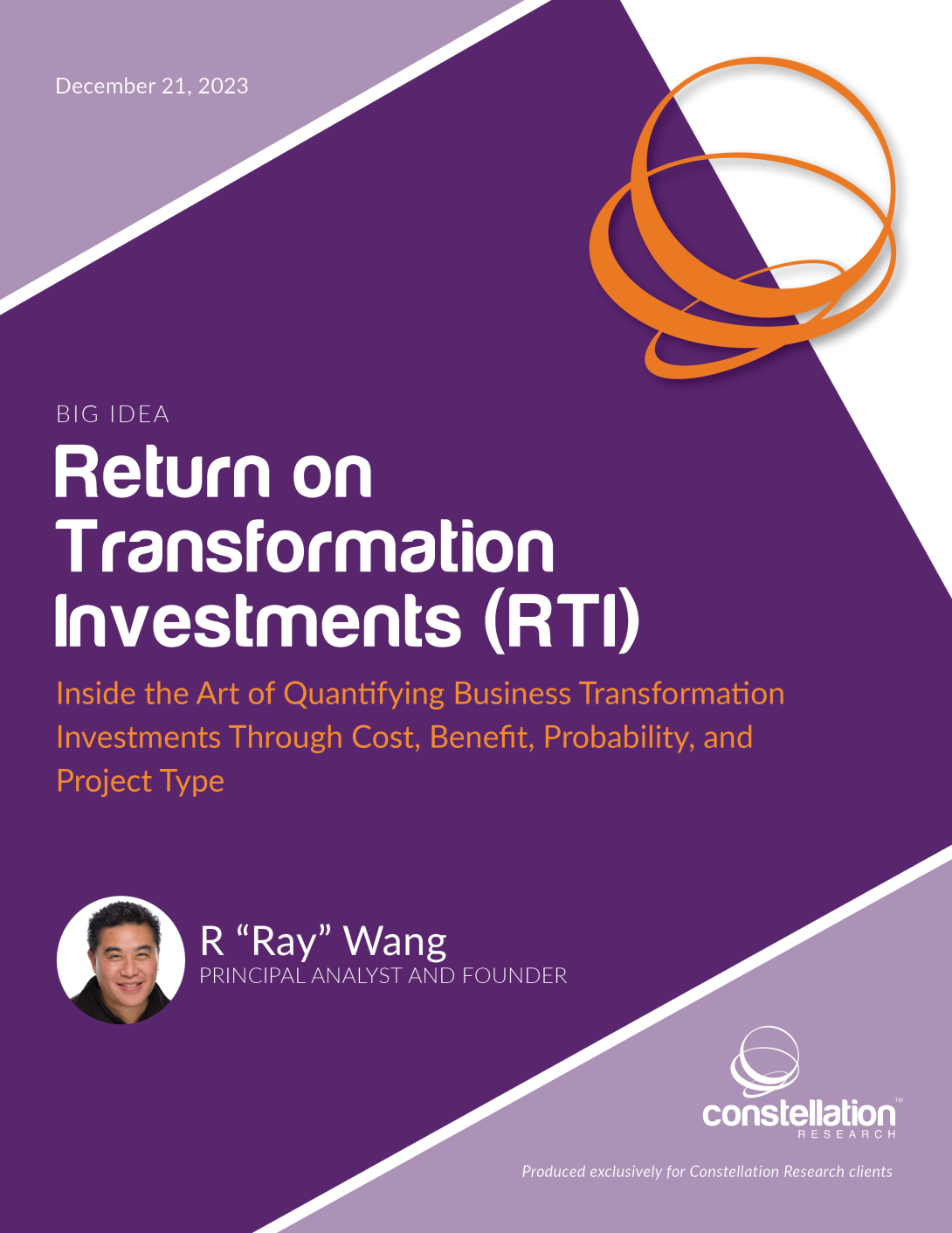
Big Idea: Return on Transformation Investments (RTI)
Executive Summary
Many organizations have performed classical cost-benefit analyses to determine the impact of business technology projects. Although these approaches account for the quantifiable metrics, they often fail to capture key attributes such as probability of success and level of difficulty in project type.
Today’s artificial intelligence (AI) and business transformation projects require a much more holistic approach when evaluating the value created for an entire organization. Consequently, boards and their executives seek richer attributes to augment their traditional decision-making techniques.
Welcome to Constellation’s Return on Transformation Investment (RTI) methodology to provide decision support for business and technology leaders in their investment analyses. The methodology accounts for four elements that must be considered for any digital transformation project: cost, benefit, probability, and project type.
Quantiyfing Success In Business Transformation Requires New Techniques For Measurement
Old-school return on investment (ROI) calculations and legacy ownership cost calculations have not been modernized for the world of digital transformation. The understanding of economic impact is not enough to determine successful transformation. In conversations with more than 200 leading business transformation executives, Constellation found that most believe existing techniques fail to provide a holistic and pragmatic perspective for a few reasons:
- The long view is often ignored in short-term project execution. Even though business transformation projects have longer time frames, most business leaders and technology executives work from yearly budgets but live quarter to quarter. With an average tenure of 2.8 years for transformation leaders, the incentives are not in alignment with long-term benefits. In fact, most ROI calculations fail to consider the longer-term impact analysis.
- Likelihood of success not considered in investment analysis. Armed with the most complex analysis and management consulting type of projections, executives often make their case for transformation. Unfortunately, project sponsors rarely rank the likelihood of success for these transformation efforts. A proper portfolio analysis requires an understanding of a project’s propensity for success.
- Impact analysis fails to consider qualitative attributes. Organizations can easily ascertain hard metrics such as cost and benefit. However, the determination of probability and impact requires industry expertise and access to the best practices from early adopters who can provide validation.
- Project types do not reflect the level of difficulty that must be overcome. Cost takeout projects differ greatly from business model transformation. Revenue and growth initiatives are usually more complicated than operational efficiency. Compliance projects will always be funded despite economic status. Applying a difficulty factor can help organizations with prioritization of budget, resources, and time.
The Bottom Line: User RTI to Evaluate Investment Prioritization
The RTI methodology of cost, benefit, probability, and project type provides a proven approach to evaluating investment prioritization for a portfolio of transformation initiatives. Constellation recommends the following:
- Apply a consistent formal methodology to assess transformation efforts. C-level change agents agree that a formal methodology such as RTI will allow for consistent evaluation of projects and assist with prioritization. Formalizing the methodology ensures a consistent approach to quantifying and qualifying the value of a transformation initiative.
- Be diligent in developing metrics for each element. What is measured will determine what the results are. Focus on first principles and the metrics that matter.
- Consider how technology will transform business models. Focus on the business model and then see what technologies will transform the business. Every project should be driven by the business and apply exponential technologies to achieve the desired outcome.
- Determine the sustainable impact of a transformation investment. Some projects have a half-life; others provide durability. Prioritize those projects that have cultural buy-in and create enduring impact.
- Educate all stakeholders on the RTI methodology. The methodology for RTI should be taught at the level 1 and level 2 tiers of executive management. Use the RTI methodology across business units, finance, IT, and operations.
Your POV
Are you using an old ROI model that doesn't capture return on transformation? Do you need assistance considering portfolio strategy?
Add your comments to the blog or reach me via email: R (at) ConstellationR (dot) com or R (at) SoftwareInsider (dot) org. Please let us know if you need help with your strategy efforts. Here’s how we can assist:
- Developing your AI, digital business, and experience strategy
- Connecting with other pioneers
- Sharing best practices
- Vendor selection
- Implementation partner selection
- Providing contract negotiations and software licensing support
- Demystifying software licensing
Reprints can be purchased through Constellation Research, Inc. To request official reprints in PDF format, please contact Sales.
Disclosures
Although we work closely with many mega software vendors, we want you to trust us. For the full disclosure policy,stay tuned for the full client list on the Constellation Research website. * Not responsible for any factual errors or omissions. However, happy to correct any errors upon email receipt.
Constellation Research recommends that readers consult a stock professional for their investment guidance. Investors should understand the potential conflicts of interest analysts might face. Constellation does not underwrite or own the securities of the companies the analysts cover. Analysts themselves sometimes own stocks in the companies they cover—either directly or indirectly, such as through employee stock-purchase pools in which they and their colleagues participate. As a general matter, investors should not rely solely on an analyst’s recommendation when deciding whether to buy, hold, or sell a stock. Instead, they should also do their own research—such as reading the prospectus for new companies or for public companies, the quarterly and annual reports filed with the SEC—to confirm whether a particular investment is appropriate for them in light of their individual financial circumstances.
Copyright © 2001 – 2023 R Wang and Insider Associates, LLC All rights reserved.
Contact the Sales team to purchase this report on a a la carte basis or join the Constellation Executive Network
 R "Ray" Wang
R "Ray" Wang R "Ray" Wang
R "Ray" Wang